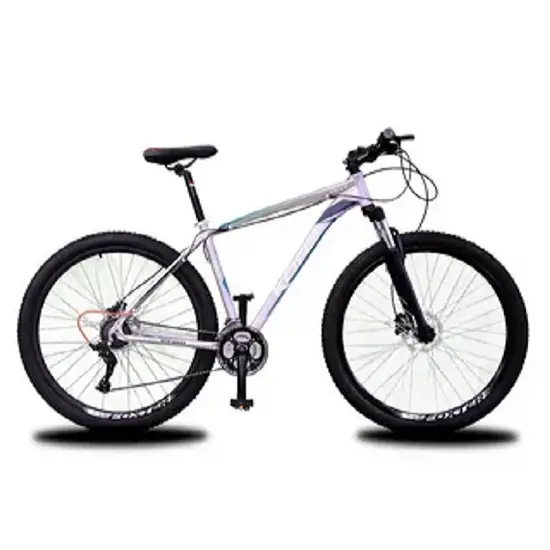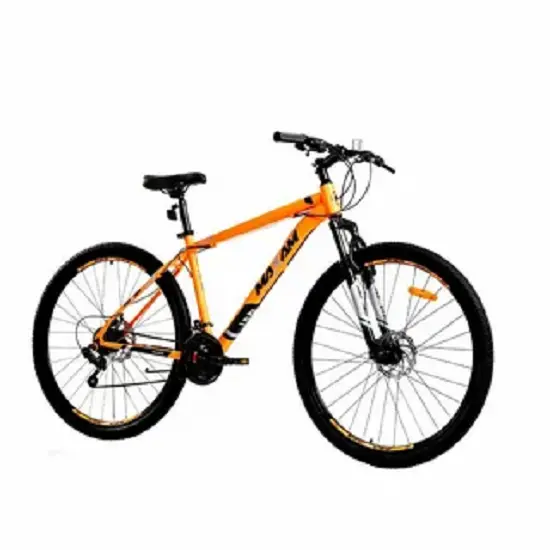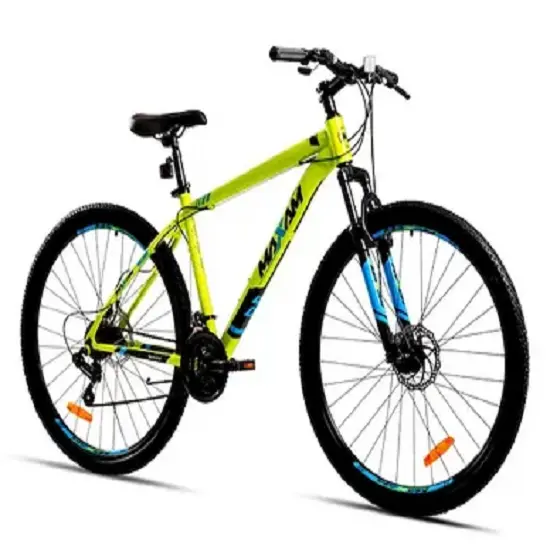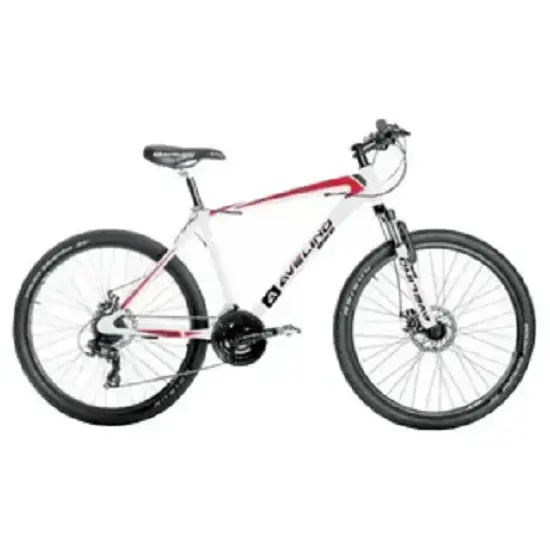Introduction to Bici Mountain Bike Rodado 29
The world of mountain biking has witnessed a significant shift in recent years, with the rise of the 29″ wheel size becoming increasingly popular among cyclists.
Also known as “29ers,” these bikes have captured the attention of both seasoned riders and newcomers alike, thanks to their impressive performance characteristics and versatility across a wide range of terrain.
At the heart of the 29er revolution is the larger wheel diameter, which offers a host of advantages over the more traditional 26″ and 27.5″ wheel sizes.
From improved rolling momentum to enhanced stability and traction, the 29″ mountain bike has proven itself to be a formidable choice for those seeking an edge on the trails.
In this comprehensive blog post, we’ll dive deep into the world of Bike Rodado 29 mountain bikes, exploring their geometry, performance attributes, suspension and component considerations, as well as their suitability for different riding disciplines.
By the end, you’ll have a thorough understanding of why the 29er has become a go-to choice for many mountain bikers.
Geometry and Fit Considerations
The adoption of the 29″ wheel size has had a significant impact on the overall geometry of mountain bikes. The larger diameter wheels result in a number of changes that affect the bike’s handling, stability, and overall performance.
Wheelbase and Chainstay Length: One of the most notable geometrical differences is the increased wheelbase and chainstay length. The larger wheels necessitate a longer wheelbase, which translates to a more stable and confident-inspiring ride, particularly at higher speeds and over technical terrain. Similarly, the chainstays need to be longer to accommodate the bigger wheels, further enhancing the bike’s stability and traction.
Head Tube Angle: Another key geometric change is the slackened head tube angle. This angle, which determines the bike’s steering responsiveness, is typically more relaxed on 29ers compared to their smaller-wheeled counterparts. The slacker head tube angle provides improved stability and steadiness, especially when navigating rough or steep sections of the trail.
Seat Tube Angle :The seat tube angle on 29″ mountain bikes is often steeper than on 26″ or 27.5″ bikes. This design choice helps to maintain an optimal pedaling position and weight distribution, ensuring efficient power transfer and improved climbing capabilities.
Frame Sizing and Fit: Selecting the right frame size is crucial when it comes to 29er mountain bikes. Due to the larger wheel size, riders may need to size up from their typical frame size to achieve the proper fit and handling characteristics. It’s essential to work with a knowledgeable bike shop or retailer to determine the optimal frame size and geometry based on your height, riding style, and preferences.
By understanding these key geometric differences, riders can ensure they select a 29er mountain bike that offers the perfect balance of stability, handling, and performance for their individual needs.
Performance Characteristics of 29″ Wheels
The larger wheel diameter of 29″ mountain bikes has a significant impact on their overall performance characteristics, providing a range of advantages that have contributed to their growing popularity.
Improved Rolling Momentum: One of the primary benefits of the 29″ wheel size is the enhanced rolling momentum. The larger circumference of the wheels allows them to maintain their speed more efficiently, requiring less effort to maintain a consistent pace.
This is particularly beneficial when tackling long, gradual climbs or rolling terrain, where the bike’s momentum can be leveraged to conserve energy and maintain a steady pace.
Better Obstacle Clearance: The taller 29″ wheels offer improved clearance over obstacles, such as rocks, roots, and other trail features. This increased ground clearance helps to smooth out the ride, allowing the bike to roll over terrain more easily and with less jarring impact. This can be especially advantageous when navigating technical sections of the trail, where the ability to float over obstacles can make a significant difference in both speed and control.
Increased Traction and Stability: The larger contact patch of the 29″ tires, combined with the bike’s increased stability due to the longer wheelbase, results in improved traction and control. This enhanced grip and stability is particularly beneficial when cornering, climbing, or descending, as the rider can feel more confident and in control of the bike’s handling.
Trade-offs in Maneuverability and Acceleration: While the 29″ wheel size offers numerous performance advantages, it does come with some trade-offs. The increased mass and inertia of the larger wheels can make the bike feel slightly less responsive and agile during tight, technical maneuvers or rapid accelerations. Riders may need to adjust their riding style and technique to accommodate the bike’s handling characteristics.
To maximize the potential of a 29er mountain bike, it’s essential to pair the right suspension and component choices with the larger wheel size, as we’ll explore in the next section.
Suspension and Component Considerations
Optimizing the suspension and component selection is crucial to unlocking the full potential of a 29″ mountain bike. The larger wheel size brings with it unique challenges and considerations that must be addressed to ensure a smooth, responsive, and efficient ride.
Suspension Design: The suspension on 29er mountain bikes requires careful tuning and optimization to account for the increased wheel size. Suspension travel may need to be adjusted to maintain the desired sag and wheel travel, ensuring the bike can effectively absorb impacts and maintain traction over rough terrain.
Additionally, suspension designs may need to be more progressive to prevent the bike from feeling overly “soft” or “plush” during hard impacts or high-speed sections. This can involve using more advanced damping components or tuning the spring and damper characteristics.
Tire Selection: The tire choice is a critical consideration for 29er mountain bikes. Wider tire widths, typically ranging from 2.3″ to 2.6″, can help to provide increased traction, cushioning, and stability on the trail. However, it’s important to strike a balance between traction and rolling resistance, as heavier, chunkier tires can negatively impact the bike’s acceleration and climbing efficiency.
Fork and Shock Choices: The selection of the front fork and rear shock components can significantly impact the performance of a 29er mountain bike. Manufacturers often design specific 29er-compatible forks and shocks to account for the increased wheel size and weight, ensuring optimal responsiveness and control.
When choosing these components, factors such as travel, stanchion diameter, and damping characteristics should be carefully considered to match the rider’s weight, riding style, and the intended terrain.
Drivetrain and Braking Systems: The larger 29″ wheels can also influence the choice of drivetrain and braking components. Riders may opt for a wider gear range to maintain optimal pedaling cadence and climbing ability, with features like 1x drivetrains or even electronic shifting becoming popular options.
Braking systems must also be appropriately sized and tuned to handle the increased momentum and weight of the 29er platform, ensuring consistent and reliable stopping power.
By carefully selecting and tuning the suspension, tires, and other components, riders can unlock the full potential of their 29″ mountain bike, tailoring the ride experience to their specific needs and preferences.
Riding Disciplines and Applications
The versatility of the 29″ mountain bike platform makes it a compelling choice for a wide range of riding disciplines and terrain. Whether you’re a cross-country racer, a technical trail blazer, or an enduro enthusiast, the 29er can be an excellent fit.
Cross-Country (XC) Racing: The 29er’s efficient rolling momentum and stable handling make it an increasingly popular choice for cross-country racing. The improved traction and momentum-carrying ability can provide a significant advantage on long, grueling climbs and technical descents. Many top-level XC racers have embraced the 29″ wheel size for its performance benefits.
Trail Riding: For general trail riding, the 29er’s blend of stability, control, and obstacle clearance make it an excellent option. The larger wheels can smooth out the ride and provide a confidence-inspiring feel, even when tackling more technical sections of singletrack. The increased traction and momentum also contribute to improved efficiency and speed on longer rides.
Enduro and All-Mountain: The 29er’s performance characteristics also lend themselves well to the demands of enduro and all-mountain riding. The improved stability and momentum can be particularly advantageous when navigating steep, rocky, or rough terrain, where the larger wheels can help maintain control and composure. Many enduro and all-mountain bike models are now available in 29″ configurations.
Bike Park and Downhill: While the 29er platform may not be the first choice for pure downhill or bike park riding, some riders have found success using 29ers in these disciplines as well. The increased stability and momentum can be beneficial when navigating high-speed, technical sections, though the bike’s handling may require some adaptation from riders more accustomed to smaller wheel sizes.
Ultimately, the choice of wheel size for a mountain bike will depend on the rider’s terrain, riding style, and personal preferences. Many manufacturers now offer a range of 29er models to cater to the diverse needs of the mountain biking community.
Advantages of the 29″ Mountain Bike
The growing popularity of the 29″ mountain bike can be attributed to several key advantages that have made it a compelling choice for riders across a wide range of disciplines:
Improved Rolling Momentum: The larger 29″ wheel diameter allows the bike to maintain its speed more efficiently, requiring less effort from the rider to maintain a consistent pace. This can be particularly beneficial when climbing, navigating technical terrain, or riding at higher speeds.
Enhanced Stability and Traction: The increased contact patch of the 29″ tires, combined with the bike’s longer wheelbase and slacker geometry, provides superior stability and traction. This can translate to improved control, confidence, and performance, especially when cornering, descending, or navigating rough or loose surfaces.
Increased Obstacle Clearance: The taller 29″ wheels offer better clearance over obstacles, such as rocks, roots, and other trail features. This can help to smooth out the ride and reduce the impact of impacts, allowing the rider to maintain momentum and control more effectively.
Adaptability Across Disciplines; The versatility of the 29er platform makes it a viable option for a wide range of riding disciplines, from cross-country racing to enduro and all-mountain exploration. This adaptability can be particularly appealing for riders who want a single bike that can perform well in diverse terrain and conditions.
Improved Comfort and Compliance: The larger wheel size can contribute to a more comfortable ride, as the larger diameter and increased tire volume can help to absorb impacts and provide a smoother, more compliant feel over rough terrain.
Increased Confidence and Control: The combination of improved stability, traction, and obstacle clearance can instill a greater sense of confidence and control in the rider, particularly when tackling technical or challenging sections of the trail.
These advantages have made the 29″ mountain bike a popular choice among riders seeking an edge in performance, efficiency, and versatility on the trails.
Case Study: Transitioning from a 26″ to a 29″ Mountain Bike
To illustrate the real-world impact of the 29er platform, let’s consider the case of a seasoned mountain biker, Sarah, who made the switch from a 26″ wheel bike to a 29er.
Sarah had been riding a 26″ trail bike for several years, and while she was comfortable with its handling and performance, she found herself struggling on longer, more technical rides. She often felt fatigued from having to work harder to maintain momentum and overcome obstacles.
After reading about the advantages of 29er mountain bikes, Sarah decided to test ride a few models at her local bike shop. She was immediately impressed by the increased stability and traction of the larger wheels, and the bike’s ability to roll over obstacles with greater ease.
During her first few rides on the 29er, Sarah noticed a significant difference in her overall efficiency and control. The improved rolling momentum allowed her to maintain a steadier pace, even on long climbs, and she felt more confident navigating rocky, root-laden sections of the trail.
One of the most noticeable improvements for Sarah was the increased stability and composure of the 29er, particularly when descending steep or technical terrain. The longer wheelbase and slacker geometry provided a more planted and secure feeling, allowing her to carry greater speed and tackle challenges with more confidence.
Over time, Sarah also found that the 29er’s enhanced traction and obstacle clearance reduced the physical toll on her body, as she no longer had to work as hard to keep the bike moving and under control. This translated to increased endurance and the ability to ride longer, more challenging routes without succumbing to fatigue as quickly.
Sarah’s seamless transition to the 29er mountain bike highlights the real-world benefits that this platform can offer, from improved efficiency and control to enhanced comfort and confidence on the trails.
Conclusion
The 29″ mountain bike has undoubtedly made a significant impact on the world of off-road cycling, offering a compelling blend of performance, versatility, and technological advancements. With its improved rolling momentum, enhanced stability and traction, and increased obstacle clearance, the 29er has become a go-to choice for riders across a wide range of disciplines.
Whether you’re a cross-country racer seeking an edge, a trail enthusiast craving a more confident and composed ride, or an enduro/all-mountain rider looking to tackle technical terrain with ease, the 29″ mountain bike platform has something to offer.
By understanding the key geometric considerations, performance characteristics, and component selection strategies, riders can unlock the full potential of their 29er and tailor the ride experience to their individual needs and preferences.
As the mountain biking industry continues to evolve, the 29″ wheel size is poised to remain a prominent and influential force, offering riders a compelling alternative to the more traditional wheel sizes and redefining the boundaries of what’s possible on the trails.
So, if you’re in the market for a new mountain bike or considering an upgrade, be sure to give the 29er a closer look. The advantages it offers may just be the game-changer you’ve been seeking to take your riding to the next level.
5 FAQs About 29″ Mountain Bikes
1. What are the main advantages of a 29″ mountain bike?
The key advantages of a 29″ mountain bike include:
- Improved Rolling Momentum: The larger 29″ wheels allow the bike to maintain speed more efficiently, requiring less effort from the rider to keep the momentum going, especially on long climbs and flat sections.
- Enhanced Stability and Traction: The bigger wheels provide a larger contact patch with the ground, resulting in improved stability and traction, particularly when cornering or riding on loose/technical terrain.
- Increased Obstacle Clearance: The taller 29″ wheels offer better clearance over rocks, roots, and other trail obstacles, helping to smooth out the ride.
- Adaptability Across Disciplines: 29er bikes can perform well in a variety of mountain biking disciplines, from cross-country racing to enduro and all-mountain riding.
- Improved Comfort and Control: The larger wheels and tire volume contribute to a more compliant, confidence-inspiring ride quality.
2. How does the geometry of a 29er differ from smaller wheel sizes?
29er mountain bikes typically have a slacker head tube angle, longer wheelbase, and steeper seat tube angle compared to 26″ or 27.5″ bikes. This geometry is designed to provide enhanced stability and traction while maintaining efficient climbing capabilities.
3. What are some key suspension and component considerations for 29ers?
Proper suspension tuning, wider tire widths (2.3″-2.6″), and 29er-specific fork/shock designs are important to optimize the performance of a 29″ mountain bike. Drivetrain and braking systems may also need to be selected to accommodate the larger wheel size.
4. What type of riding disciplines are 29ers best suited for?
29er mountain bikes excel in a variety of disciplines, including cross-country racing, trail riding, enduro, and all-mountain exploration. Their versatility makes them a popular choice across the sport.
5. Can riders easily transition from a 26″ to a 29″ bike?
Many riders find the transition from a 26″ to a 29″ mountain bike to be quite seamless, with noticeable improvements in efficiency, stability, and confidence on the trails. The larger wheels may require some adjustments to riding technique, but the benefits often outweigh any learning curve.

With over 9 years of dedicated experience in the automotive industry, I am passionate about all things automotive. My journey began with a deep curiosity for automobiles, which led me to delve deeper into their mechanics, technology and trends. My expertise spans various aspects of the automotive world, from the latest electric vehicles to classic car restoration techniques. Through my articles, I aim to share my knowledge and insights, helping readers stay informed and inspired in the fast-paced world of the automobile.














